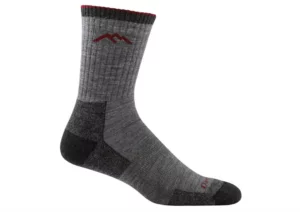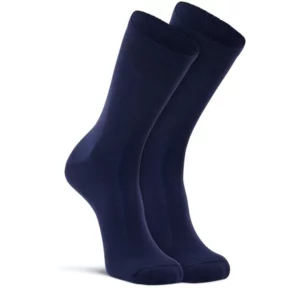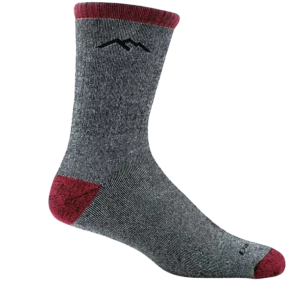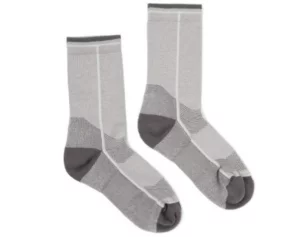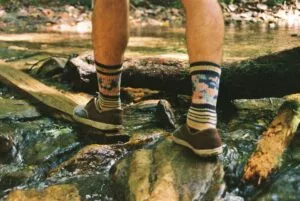
The Best Hiking Socks in Canada
Wearing a good pair of hiking socks for your outdoor adventurers is important. Without a good pair, your feet will get sore, develop blisters, and overheat. To prevent these things from happening, you will need socks that provide protection and support. That way, your feet will be comfortable for your entire hike.
There are countless hiking socks to choose from. With all the options available, selecting the right pair can be a daunting task. That’s why we have created this buying guide to list the best hiking socks in Canada.
Our picks
What to look for in a hiking sock
Fabric: Hiking socks are made from different types of fabric. They are usually combined to make the sock. The following are common fabrics used to make hiking socks:
- Wool: This is the most popular fabric for hiking socks. Wool regulates temperature well and provides good cushioning. Merino wool is used by many brands in their hiking socks. This type of wool has natural antimicrobial properties to eliminate odors. Merino wool is also itch free. Because of its features, you can wear a pair of wool socks all year round.
- Polyester: Unlike wool, polyester is a synthetic fabric. It insulates well, wicks moisture, and dries quickly. Polyester has good ventilation, making it good for warm weather. Compared to wool, polyester is much more durable. However, it does not eliminate odors as well.
- Nylon: Occasionally, nylon is used as a primary material for hiking socks. However, its main function is to add durability and improve drying times.
- Silk: This fabric is primarily used as an insulator. Silk is also used to wick moisture in sock liners.
- Spandex: Most hiking socks will have a small amount of spandex. This fabric helps the sock hold its shape (i.e., prevents it from bunching up).
Most socks blend wool and synthetic fabrics together. This combination improves the overall quality of the hiking sock.
Height: The general guideline for height is that your hiking sock should match the height of your hiking boot or shoe’s cuff. That way, your ankle and leg are not rubbing against the cuff as you hike. Here are some common heights for hiking socks:
- Crew: This is the most common height for hiking socks. Crew socks rest a few inches above the ankle bone. These socks protect your ankle from abrasions if your hiking boots or shoes have high cuffs.
- Quarter/ankle: These socks are slightly smaller than crew socks. They cover the heel and ankle but do not rise as high.
- No-show: These socks are very short and provide little or no protection for your ankles. No-show socks are best worn with low cut footwear like trail-running shoes or light hiking shoes.
- Over-the-calf/knee-high: As the tallest hiking socks, over-the-calf or knee-high socks provide the most protection. They cover most of your lower leg and are good for off-trail hiking. These socks are also good for cold conditions as they provide lots of warmth.
Cushioning/Comfort: The amount of cushioning tells you how thick the sock is. The more cushioning a hiking sock has, the more comfortable it will feel. Socks with no or light cushioning are ultra light and thin. They have very little padding for your feet, which means they lack in comfort. This makes light cushioned socks best for shorter, easier hikes. On the plus side, they are very breathable, making them good hiking socks for summer weather.
Medium and heavy cushioned socks offer a good amount of comfort for your feet. This makes them good options for longer, tougher hikes. Since they are thicker, these hiking socks provide more warmth in cold weather. However, they are not always the best option for hot conditions.
Best wool socks
Darn Tough Hiker Micro Crew
These hiking socks from Darn Tough are made from merino wool. Therefore, the socks effectively wick moisture, regulate temperature, and dry fast. Because of its breathability, the Darn Tough Hiker Micro Crew socks work for both spring/summer. However, these socks are thick enough for winter hikes. The socks have a medium cushion to support the heels, toes, and arch of your foot. Lastly, the socks have a comfortable fit that prevents them from slipping off, bunching up, or creating blisters.
Many people commented on these socks’ durability. They liked that the merino wool kept the sock odor free, even after long, hot hikes. Customers also found that the Darn Tough Hiker Micro Crew socks kept their feed warm in the cold. On the downside, these socks are expensive. On REI, one pair costs $24.00 US, while on Amazon they cost around $50.00 Canadian.
Pros
- Can be worn year round.
- Eliminates odors.
Cons
- Expensive.
Best hiking socks for summer
Fox River Auras Liner Socks
The best summer hiking socks should be light and breathable. The Fox River Aura Liner Socks fits both those categories. This hiking sock is made from synthetic materials, which makes it thin and ultra light. Polypropylene, the main material in the sock, fights moisture build up and prevents the sock from rubbing against the skin. It also provides warmth without any added weight.
Because of its thin design and light weight, many people recommended this sock for spring and summer hikes. Customers thought that these Fox River socks were breathable and kept their feet dry during long hikes in hot temperatures. Others said that the socks effectively prevented blisters. However, the sock’s thin fabric makes it prone to rips. While this was not a widespread issue, some people complained that their pair ripped.
Pros
- Good ventilation.
- Socks prevent moisture build-up and blisters.
Cons
- Thin fabric makes it prone to rips.
Best hiking socks for winter
Darn Tough Mountaineering Socks
If you are looking for a pair of socks to keep feet warm during cold hikes, then the Darn Tough Mountaineering socks are a good option for you. These socks are thick and have heavy cushioning. They rest around your calf area, which provides plenty of protection for your ankles and legs. The main fabric in this sock is merino wool. Therefore, the Darn Tough Mountaineering Socks have all the benefits of merino wool like breathability moisture wicking.
Customers agreed that these socks worked for winter hiking. Many people said the socks kept their feet warm and comfortable even in the coldest of conditions. The heavy cushioning gave their feet added support. Others said the socks actually stay up around the calves and knees; they do not fall down as you hike. The odor fighting capabilities of merino wool allowed people to wear the socks for several consecutive days. However, some people said these socks were too tight for them. This issue only happened to people with large or wide feet. Also, the price for one pair is expensive.
Pros
- Keeps feet warm during cold hikes.
- Heavy cushioning gives lots of support.
Cons
- Socks may be tight fitting for people with large or wide feet.
- Expensive
Best budget hiking socks
REI Co-op Coolmax Socks
You may have noticed that hiking socks can be expensive. Luckily, there are affordable options. The REI Co-op Coolmax socks are $15.95 U.S., which is much lower than many hiking socks available. These hiking socks are made from recycled polyester, which makes them eco-friendly. It is an ultralight sock designed to be breathable. For foot support, the sock is constructed to protect the heels, toes, Achilles, and footbeds from the wear and tear of hiking. Additionally, the spandex yarn provides more arch support. The REI Co-op Coolmax socks are designed to be durable and comfortable. The nylon fabric ensures the socks are long lasting, while the spandex yarn works to improve the fit.
Several customers were surprised at the value of these hiking socks. One customer said that it exceeded their expectations for budget hiking socks. Overall, people said that the REI Co-op Coolmax socks were comfortable, breathable, and long lasting. Some people found these socks to be thicker than they expected. The socks are advertised as ultralight, so its thickness came as a surprise to some. This unexpected thickness may turn away customers looking for an affordable thin hiking sock.
Pros
- Affordable
Cons
- Sock feels thicker than advertised.
Our methodology
For this buying guide, we spent over eight hours examining various hiking socks. We only considered pairs rated four or more stars by customers. To help us with our research, we read several customer reviews. These reviews showed us what people look for in the best hiking socks. Our picks were based on the durability, comfort, and support of the hiking sock.
Frequently asked questions about hiking socks
Why are hiking socks important?
The importance of hiking socks lies in the protection and support they give your feet. A good pair of hiking socks keep your feet from overheating and protects them from abrasions. This prevents blisters or hotspots from happening. And if you hike in the winter, hiking socks should keep your feet warm the entire time. If you do not wear hiking socks during your hike, chances are your feet will end up sore, sweaty, and blistered. In the end, your hiking socks should keep your feet comfortable for the entirety of your hike.
Where can I buy hiking socks?
You can buy hiking socks at many outdoor sports stores like Sportchek and MEC. Online outlets like Amazon and REI also sell hiking socks.
What is the best material for hiking socks?
This is a tough question to answer because each fabric has their pros and cons. Synthetic fabrics like polyester or nylon are durable and breathable. But they have a hard time of eliminating odors. Wool socks are also breathable. Plus they provide good support, and the fight off odors well. However, they do not last as long. In the end, we believe that a blend of wool (preferably merino wool) and synthetic fabrics is the best material for hiking socks. Combining the two fabrics gives you the best possible hiking sock.
What is the difference between hiking socks and regular socks?
You may be wondering what the difference is between a hiking sock and a regular sock. A key difference is the material of the sock. Most regular socks are made from cotton. This fabric does a poor job of wicking moisture, regulating temperature, and standing up to the wear and tear of hiking. That is why your feet will end up sweaty, sore, and full of blisters when you wear regular socks on your hike. And as we covered earlier, hiking socks do a better job of keeping your feet comfortable and protected during your hike.
Are acrylic socks good for hiking?
Acrylic is a synthetic fiber which is used in to make some hiking socks. According to Wikipedia, Acrylic fiber “is lightweight, soft, and warm, with a wool-like feel”. It can also be used to mimic other fibers, like wool. Based on this information, acrylic socks are good for hiking.
Read more

The Best Camping Stoves in Canada
If you want to take your camp cooking to the next level, then a camping stove is the appliance for you.

The Best Hiking Backpacks in Canada
Hiking backpacks are an important thing to have for a hike. That’s why we created this buying guide.

The Best Sleeping Bags and Quilts in Canada
The best thing after a long day in nature is a good night’s sleep.
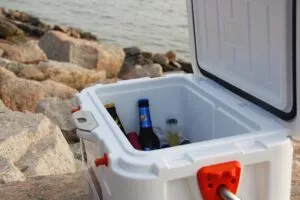
The Best Coolers In Canada
Looking to keep your drinks cold all summer? This cool guide will help you pick the best cooler.
